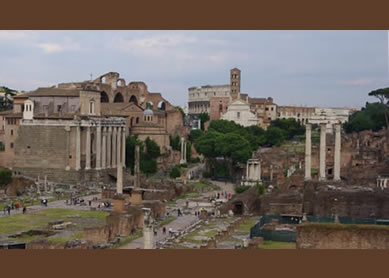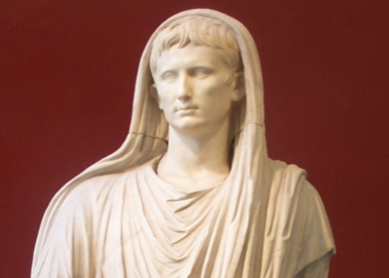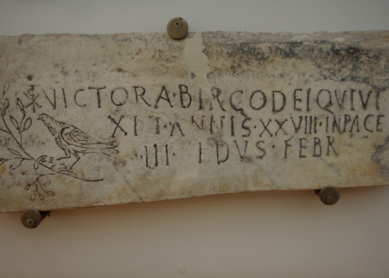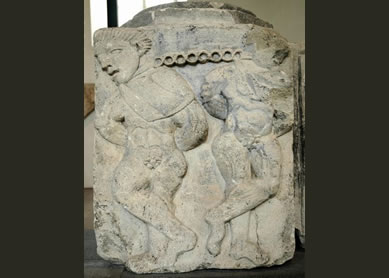The city of Rome grew into a multi-continental empire by the first century BCE, which required a major change in its governing structures and led to a succession of dynastic families in power. Imperial rule was initiated by Julius Caesar, who tried to resolve a political crisis in Rome: the ever-expanding empire had outgrown its city-state institutions and its leadership structure, which consisted of a pair of annually selected executive officials called consuls. Caesar’s attempt at control as a singular leader with lifelong powers was met with intense resistance and led to his murder on the Ides of March 44 BCE. It was not until his adoptive son, Octavian, beat the last of his enemies at the Battle of Actium in 31 BCE that imperial rule was solidified in the hands of Caesar’s family, establishing dynastic rule. Octavian received the title “Augustus” (a religious term meaning “grand”) from the Senate, which became his name thereafter, as well as the imperial title for all later emperors. Augustus’s wife, Livia, received a parallel female title—Augusta—as did the wives of subsequent emperors. Augustus thus instituted the political, military, and economic hegemony of the imperial family over the vast empire, appropriating all aspects of leadership.
Who were the Roman emperors?
The first family to maintain power for almost a century were the Julio-Claudians, heirs of Augustus and Livia: Tiberius, Caligula, Claudius, and Nero. Imperial family members, especially potential heirs, were groomed to become emperors, and the ensuing familial infighting, rich with intrigue and murder, eventually led to the end of the dynasty in 68 CE. A war among four competing emperors ended with the victory of the Flavian dynasty (69-96 CE): Vespasian and his heirs, Titus and Domitian.
The second dynasty ended disastrously as well, and in the following century, emperors were selected on the basis of ability rather than heredity. The ideal of familial inheritance was retained nevertheless by having the current emperor adopt a contender as his son. Thus Trajan, Hadrian, Antoninus Pius, and Marcus Aurelius became imperial heirs through adoption, not birth. When Marcus Aurelius allowed his biological son, Commodus, to become his heir, it proved catastrophic and led to another year of empire-wide military conflict in 193 CE. This conflict ended in the victory of the North African Severan family, which included the emperors Septimius Severus and Caracalla. Following the murder in 235 CE of the last member of the Severan dynasty, a fifty-year crisis ensued during which no emperor was able to establish a dynasty. Stability returned with Diocletian and ultimately Constantine the Great, who reorganized the empire and introduced territorial divisions to better defend against ongoing invasions.
How did Roman emperors maintain their power?
The Roman military could have never controlled the full extent of the empire by military might. Its initial conquests were followed by the Romanization of local elites, whose status now depended on the maintenance of Roman rule. This frequently entailed their participation in the religious aspects of imperial rule. Roman emperors were always considered religious leaders and thus responsible for maintaining the goodwill of the gods towards the empire. The emperor took on a role in all priestly colleges, such as the augurs, and most notably became pontifex maximus, the head of the major college of priests responsible for both ceremony and religious law in Rome. Even more importantly, Augustus was already worshipped in his lifetime by most of his subjects outside of Italy (and even some in Italy) as divine. Most of his heirs continued to be honored in this way, as did their wives and some other family members. The inclusion of family members in imperial worship was related to the newly popular representations of the first family. Augustus’s wife, Livia, was the first woman to be depicted on coins and statuary on a large scale, and such representation of domesticity came to lasting prominence with the importance of dynastic inheritance under Augustus.
The imperial cult was shared by the whole empire and offered some leverage over imperial behavior by establishing positive expectations for benevolent rule. Emperors who fell far short of such expectations would gain no divinization upon death and suffer an erasure of their memory: so-called damnatio memoriae, the physical removal of their names from public monuments. Imperial rule was widely represented from coins to large-scale reliefs, with depictions of the emperor and imperial family in their roles as military and religious leaders. Given the importance of symbolism for maintaining imperial control over a vast area, the on-going representation of emperors and their families as generous, virtuous leaders and their worship among large segments of the empire’s population in the imperial cult were critical to their success.





